William and Mary Kingwood or ‘Princes’ wood oyster cabinet on chest
circa 1690. England. Attribution: Thomas Pistor
SOLD
Request Information
Follow Us
William and Mary Kingwood or ‘Princes’ wood oyster cabinet on chest
circa 1690. England
Attribution: Thomas Pistor
When the most expensive timber of the 17th century met Thomas Pistor…
There were, in fact, two cabinet-makers called Thomas Pistor, father and son, working for a period at the same time but at different premises. One or both are known to have made furniture of quality for Levens Hall.
From the 4-18 August, 1950 Country Life ran a series of articles featuring what was then the recently rebuilt Buxted Park, a house reconstructed by the architect Basil Lonides following a serious fire and in one of the illustrations a kingwood escritoire is visible. Subsequently, Christopher Gilbert commented in ‘The Dictionary of Marked London Furniture’, Leeds, 1996, p.44 that a “highly important kingwood fall-front cabinet inscribed ‘Thomas Pistor, Ludgate Hill, London’, formerly owned by the Hon. Basil Ionides, unfortunately, remains untraced. It was amongst the Buxted Park furniture at Sotheby’s, 25 September 1963, lot 168 (withdrawn)…”. The whereabouts of this escritoire remain unknown and further details of how the pieces are marked remain uncertain.
The overall profile and proportions of the Buxted escritoire conform to that of this cabinet on chest and the ‘W. R. Harvey’ cabinets as does the pattern of oysters.
Condition
Provenance
Literature
Dimensions
PREVIOUSLY SOLD
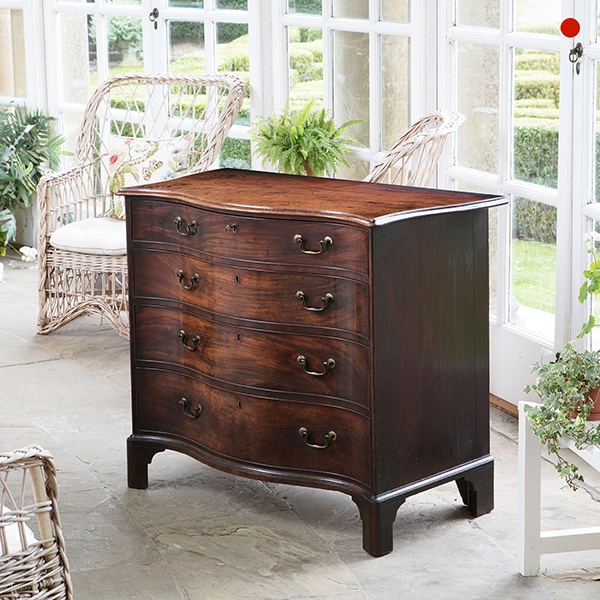
A fine George III mahogany serpentine chest of drawers in the manor of Henry Hill of Marlborough
A fine George III mahogany serpentine chest of drawers in the manner of Henry Hill. With ebonised, ogee moulded serpentine dovetail-housed top.

William and Mary Kingwood or ‘Princes Wood’ Oyster Table Box
William & Mary Kingwood Oyster Table Box or ‘Princes Wood’, Circa 1690. England. Originally designed to store tableware and was given the apt name ‘table box’.
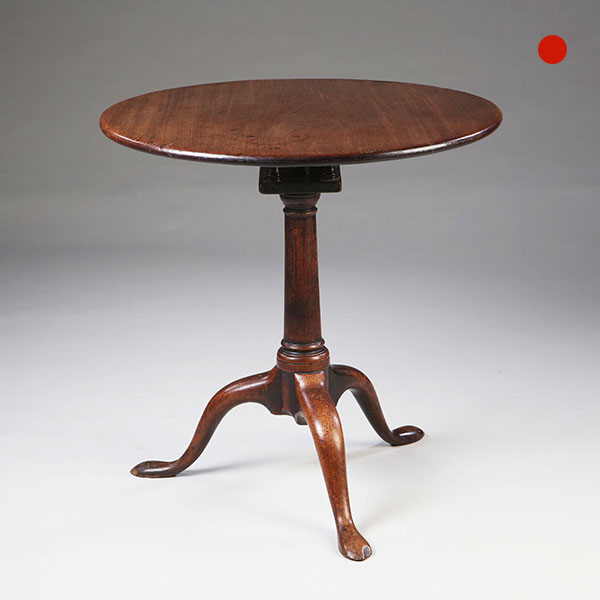
George III Mahogany Tripod or Snap
George III Mahogany Tripod Table or Snap-Top Table with Birdcage circa 1770. England SOLD Follow UsGeorge III Mahogany Tripod or Snap-Top Table with Birdcage, circa 1770. England Of solid mahogany, the gun barrel and one-piece top are raised...
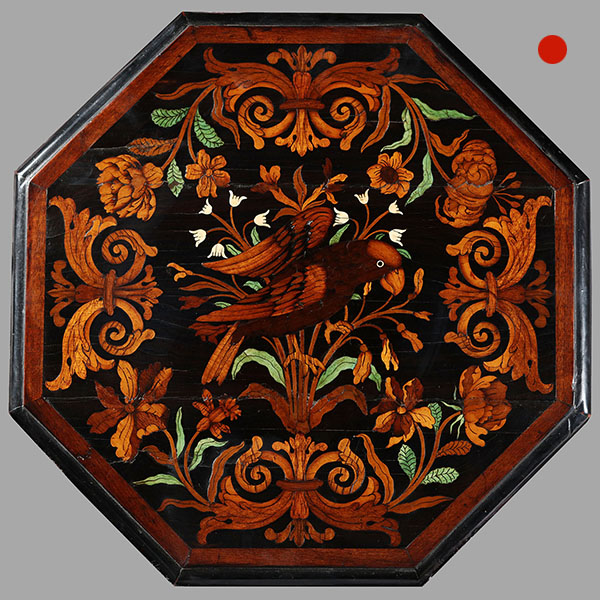
17th-Century Floral Marquetry Candle Stand
17th-Century Floral Marquetry Candle Stand, 1675-1690. The Metropolitan Museum of Art in New York decided to auction a number of pieces of exceptional merit.
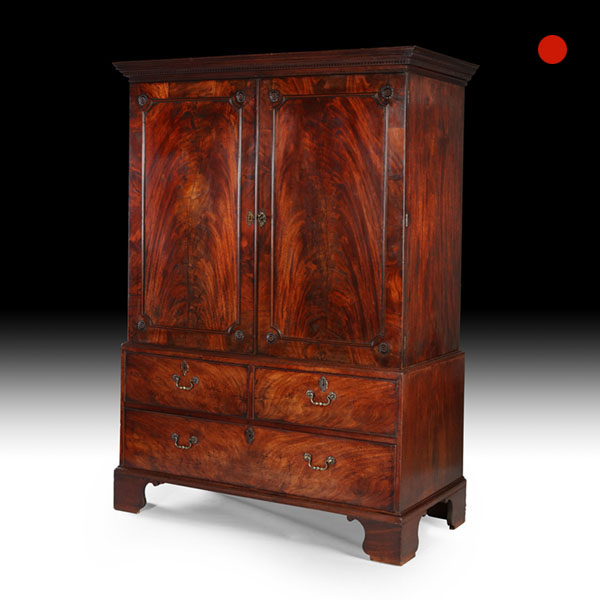
George III Mahogany Linen Press Wardrobe
George III Mahogany Linen Press Wardrobe 1760 England SoldGeorge III Mahogany Linen Press Wardrobe A fine George III mahogany linen press in outstanding original condition. The press was obviously made to exceed with the cabinetmaker using...
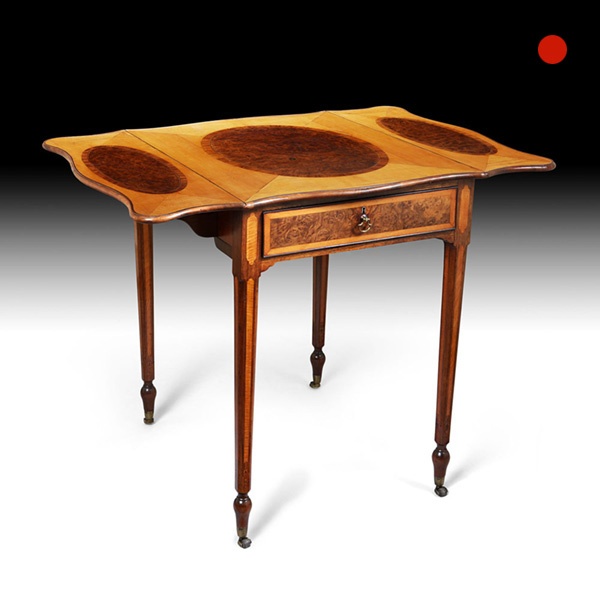
18th Century George III Satinwood and Pollard Oak Pembroke Occasional Table
An exceptionally fine and rare George III satinwood and pollard oak Pembroke table. The padauk top is veneered in satinwood cantered by large ovals of tightly clustered burr pollard oak reserves, bordered in princess wood and lined with fine ebony and box stringing.

A fine George III mahogany serpentine chest of drawers in the manor of Henry Hill of Marlborough
A fine George III mahogany serpentine chest of drawers in the manner of Henry Hill. With ebonised, ogee moulded serpentine dovetail-housed top.

William and Mary Kingwood or ‘Princes Wood’ Oyster Table Box
William & Mary Kingwood Oyster Table Box or ‘Princes Wood’, Circa 1690. England. Originally designed to store tableware and was given the apt name ‘table box’.

George III Mahogany Tripod or Snap
George III Mahogany Tripod Table or Snap-Top Table with Birdcage circa 1770. England SOLD Follow UsGeorge III Mahogany Tripod or Snap-Top Table with Birdcage, circa 1770. England Of solid mahogany, the gun barrel and one-piece top are raised...

17th-Century Floral Marquetry Candle Stand
17th-Century Floral Marquetry Candle Stand, 1675-1690. The Metropolitan Museum of Art in New York decided to auction a number of pieces of exceptional merit.

George III Mahogany Linen Press Wardrobe
George III Mahogany Linen Press Wardrobe 1760 England SoldGeorge III Mahogany Linen Press Wardrobe A fine George III mahogany linen press in outstanding original condition. The press was obviously made to exceed with the cabinetmaker using...

18th Century George III Satinwood and Pollard Oak Pembroke Occasional Table
An exceptionally fine and rare George III satinwood and pollard oak Pembroke table. The padauk top is veneered in satinwood cantered by large ovals of tightly clustered burr pollard oak reserves, bordered in princess wood and lined with fine ebony and box stringing.
YOU MAY ALSO LIKE

Engraved Eight-Day Striking and Repeating Carriage Clock by Perregaux Au Locle
Engraved Eight-Day Striking and Repeating Carriage Clock by Perregaux Au Locle Follow UsEngraved Eight-Day Striking and Repeating Carriage Clock by Perregaux Au Locle The superb engraved gilt gorge brass case has facetted glass panels to all...

Fine George III 18th Century Period Mahogany Longcase Clock by Tomas Fowle
18th Century Period Mahogany Longcase Clock by Tomas Fowle £12,995 Follow Us18th Century Period Mahogany Longcase Clock by Tomas Fowle A fine George III period mahogany longcase clock of excellent colour, patination and proportions, circa...

17th Century Figured Walnut and Seaweed Marquetry Lace Box
17th Century Figured Walnut and Seaweed Marquetry Lace Box £3,600 Follow Us17th Century Figured Walnut and Seaweed Marquetry Lace Box A fine and extremely rare figured walnut and seaweed marquetry 'lace box', circa.... let’s break it down -...

19th Century Repeating Gilt-Brass Carriage Clock by the Famous Drocourt
19th Century Repeating Gilt-Brass Carriage Clock by the Famous Drocourt £5,600 Follow Us19th Century Repeating Gilt-Brass Carriage Clock by the Famous Drocourt A superb repeating carriage clock with a gilt-brass gorge case by the famous maker...

17th-Century Hague Clock Signed by Pieter Visbagh, circa 1675
Small 17th Century Hague clock made c. 1675 by Pieter Visbagh, who was apprenticed by Salomon Coster. The latter made the first pendulum clock according to the instructions of Christiaan Huygens, the internationally renowned scientist who developed the idea of applying a pendulum to a clock movement.

Pair of 18th-Century English Rococo Gilt Bronze Andirons or Firedogs
An exceptional pair of 18th century English Rococo gilt bronze andirons or fire dogs.
The bold shape of these andirons relate to designs of Thomas Johnson (1714–1778), one of London’s pioneers of the ‘Modern’ or French style, later known as Rococo.

Engraved Eight-Day Striking and Repeating Carriage Clock by Perregaux Au Locle
Engraved Eight-Day Striking and Repeating Carriage Clock by Perregaux Au Locle Follow UsEngraved Eight-Day Striking and Repeating Carriage Clock by Perregaux Au Locle The superb engraved gilt gorge brass case has facetted glass panels to all...

Fine George III 18th Century Period Mahogany Longcase Clock by Tomas Fowle
18th Century Period Mahogany Longcase Clock by Tomas Fowle £12,995 Follow Us18th Century Period Mahogany Longcase Clock by Tomas Fowle A fine George III period mahogany longcase clock of excellent colour, patination and proportions, circa...

17th Century Figured Walnut and Seaweed Marquetry Lace Box
17th Century Figured Walnut and Seaweed Marquetry Lace Box £3,600 Follow Us17th Century Figured Walnut and Seaweed Marquetry Lace Box A fine and extremely rare figured walnut and seaweed marquetry 'lace box', circa.... let’s break it down -...

19th Century Repeating Gilt-Brass Carriage Clock by the Famous Drocourt
19th Century Repeating Gilt-Brass Carriage Clock by the Famous Drocourt £5,600 Follow Us19th Century Repeating Gilt-Brass Carriage Clock by the Famous Drocourt A superb repeating carriage clock with a gilt-brass gorge case by the famous maker...

17th-Century Hague Clock Signed by Pieter Visbagh, circa 1675
Small 17th Century Hague clock made c. 1675 by Pieter Visbagh, who was apprenticed by Salomon Coster. The latter made the first pendulum clock according to the instructions of Christiaan Huygens, the internationally renowned scientist who developed the idea of applying a pendulum to a clock movement.

Pair of 18th-Century English Rococo Gilt Bronze Andirons or Firedogs
An exceptional pair of 18th century English Rococo gilt bronze andirons or fire dogs.
The bold shape of these andirons relate to designs of Thomas Johnson (1714–1778), one of London’s pioneers of the ‘Modern’ or French style, later known as Rococo.









